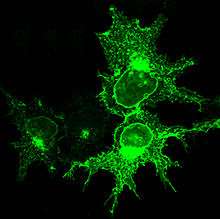KIAA0319
KIAA0319 is a protein which in humans is encoded by the KIAA0319 gene.[3][4]
Clinical significance
Variants of the KIAA0319 gene have been associated with developmental dyslexia.[5]
Reading disability, or dyslexia, is a major social, educational, and mental health problem. In spite of average intelligence and adequate educational opportunities, 5 to 10% of school children have substantial reading deficits. Twin and family studies have shown a substantial genetic component to this disorder, with heritable variation estimated at 50 to 70%.[3]
An NIDCD-supported investigator recently has identified a mutation in a gene on chromosome 6, called the KIAA0319 gene, that appears to play a key role in Specific Language Impairment.[6]
Function

Over-expression of C-terminally myc-tagged KIAA0319 protein in transiently transfected 293T cells, showing plasma membrane localization. Detection with monoclonal anti-myc 9E10.
The KIAA0319 protein is expressed on the cell membrane and may be involved in neuronal migration. Furthermore, KIAA0319 follows a clathrin-mediated endocytic pathway[7]
References
- ↑ "Human PubMed Reference:".
- ↑ "Mouse PubMed Reference:".
- 1 2 "Entrez Gene: KIAA0319 KIAA0319".
- ↑ Nagase T, Ishikawa K, Nakajima D, Ohira M, Seki N, Miyajima N, Tanaka A, Kotani H, Nomura N, Ohara O (April 1997). "Prediction of the coding sequences of unidentified human genes. VII. The complete sequences of 100 new cDNA clones from the brain which can code for large proteins in vitro". DNA Res. 4 (2): 141–50. doi:10.1093/dnares/4.2.141. PMID 9205841.
- ↑ Cope N, Harold D, Hill G, Moskvina V, Stevenson J, Holmans P, Owen MJ, O'Donovan MC, Williams J (April 2005). "Strong evidence that KIAA0319 on chromosome 6p is a susceptibility gene for developmental dyslexia". Am. J. Hum. Genet. 76 (4): 581–91. doi:10.1086/429131. PMC 1199296
 . PMID 15717286.
. PMID 15717286. - ↑ https://www.nidcd.nih.gov/health/voice/pages/specific-language-impairment.aspx
- ↑ Levecque C, Velayos-Baeza A, Holloway ZG, Monaco AP (July 2009). "The dyslexia-associated protein KIAA0319 interacts with adaptor protein 2 and follows the classical clathrin-mediated endocytosis pathway". Am. J. Physiol., Cell Physiol. 297 (1): C160–8. doi:10.1152/ajpcell.00630.2008. PMC 2711651
 . PMID 19419997.
. PMID 19419997.
Further reading
- Ozçelik T, Porteus MH, Rubenstein JL, Francke U (1992). "DLX2 (TES1), a homeobox gene of the Distal-less family, assigned to conserved regions on human and mouse chromosomes 2.". Genomics. 13 (4): 1157–61. doi:10.1016/0888-7543(92)90031-M. PMID 1354641.
- Cardon LR, Smith SD, Fulker DW, et al. (1994). "Quantitative trait locus for reading disability on chromosome 6.". Science. 266 (5183): 276–9. doi:10.1126/science.7939663. PMID 7939663.
- Nagase T, Ishikawa K, Nakajima D, et al. (1997). "Prediction of the coding sequences of unidentified human genes. VII. The complete sequences of 100 new cDNA clones from brain which can code for large proteins in vitro.". DNA Res. 4 (2): 141–50. doi:10.1093/dnares/4.2.141. PMID 9205841.
- Gayán J, Smith SD, Cherny SS, et al. (1999). "Quantitative-trait locus for specific language and reading deficits on chromosome 6p.". Am. J. Hum. Genet. 64 (1): 157–64. doi:10.1086/302191. PMC 1377713
 . PMID 9915954.
. PMID 9915954.
- Nakayama M, Kikuno R, Ohara O (2003). "Protein-protein interactions between large proteins: two-hybrid screening using a functionally classified library composed of long cDNAs.". Genome Res. 12 (11): 1773–84. doi:10.1101/gr.406902. PMC 187542
 . PMID 12421765.
. PMID 12421765.
- Strausberg RL, Feingold EA, Grouse LH, et al. (2003). "Generation and initial analysis of more than 15,000 full-length human and mouse cDNA sequences.". Proc. Natl. Acad. Sci. U.S.A. 99 (26): 16899–903. doi:10.1073/pnas.242603899. PMC 139241
 . PMID 12477932.
. PMID 12477932.
- Londin ER, Meng H, Gruen JR (2004). "A transcription map of the 6p22.3 reading disability locus identifying candidate genes.". BMC Genomics. 4: 25. doi:10.1186/1471-2164-4-25. PMC 166143
 . PMID 12834540.
. PMID 12834540.
- Mungall AJ, Palmer SA, Sims SK, et al. (2003). "The DNA sequence and analysis of human chromosome 6.". Nature. 425 (6960): 805–11. doi:10.1038/nature02055. PMID 14574404.
- Francks C, Paracchini S, Smith SD, et al. (2005). "A 77-kilobase region of chromosome 6p22.2 is associated with dyslexia in families from the United Kingdom and from the United States.". Am. J. Hum. Genet. 75 (6): 1046–58. doi:10.1086/426404. PMC 1182140
 . PMID 15514892.
. PMID 15514892.
- Cope N, Harold D, Hill G, et al. (2005). "Strong evidence that KIAA0319 on chromosome 6p is a susceptibility gene for developmental dyslexia.". Am. J. Hum. Genet. 76 (4): 581–91. doi:10.1086/429131. PMC 1199296
 . PMID 15717286.
. PMID 15717286.
- Paracchini S, Thomas A, Castro S, et al. (2006). "The chromosome 6p22 haplotype associated with dyslexia reduces the expression of KIAA0319, a novel gene involved in neuronal migration.". Hum. Mol. Genet. 15 (10): 1659–66. doi:10.1093/hmg/ddl089. PMID 16600991.
- Luciano M, Lind PA, Duffy DL, et al. (2007). "A haplotype spanning KIAA0319 and TTRAP is associated with normal variation in reading and spelling ability.". Biol. Psychiatry. 62 (7): 811–7. doi:10.1016/j.biopsych.2007.03.007. PMID 17597587.
- Velayos-Baeza A, Toma C, da Roza S, et al. (2008). "Alternative splicing in the dyslexia-associated gene KIAA0319.". Mamm. Genome. 18 (9): 627–34. doi:10.1007/s00335-007-9051-3. PMID 17846832.
External links

 . PMID 15717286.
. PMID 15717286. . PMID 19419997.
. PMID 19419997. . PMID 9915954.
. PMID 9915954. . PMID 12421765.
. PMID 12421765. . PMID 12477932.
. PMID 12477932. . PMID 12834540.
. PMID 12834540. . PMID 15514892.
. PMID 15514892. . PMID 15717286.
. PMID 15717286.